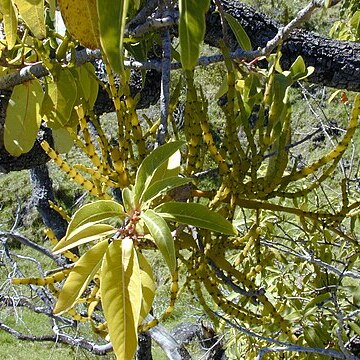Small, glabrous, erect perennials, mostly less than 15 cm high. Stems green or yellowish, articulated at nodes, terete or compressed or most often strongly flattened in one plane forming a cladode; leaves rudimentary, opposite, usually distichous but sometimes decussate, forming a border mostly less than 1 mm high around flower clusters. Flowers developing successively in lateral monoecious clusters, surrounded and separated by multicellular sparsely branched thick-walled hairs which often form a raised mound (floral cushion); first-formed flower axillary and usually male, subsequent flowers developing laterally and usually also in rows below the first, mostly female. Male flowers globose to obconical, c. 0.5 mm diam., attenuate into short stipe to 0.5 mm long, with 3 persistent triangular tepals; anthers 3, bilocular, introrse, united into a synandrium with an apical pore. Female flowers globular or pear-shaped, usually less than 0.5 mm diam.; tepals 3, persistent on fruit. Fruit pear-shaped or ellipsoidal, seldom reaching 2 mm long; seed disc-shaped, c. 1 mm diam. [See also Green (1994: 221–222).]
Plants monoecious, leafless, often less than 10 cm. high and rarely over 20 cm. high, glabrous except for the inflorescence; internodes often flattened or sometimes rounded, if flattened the compressions always in the same plane. Inflorescence apparently a modified dichasium produced laterally at the broadened nodes, the ebracteate flowers interspersed by trichomes; new flowers apparently added to the dichasial units collaterally or serially and forming dense clusters. Flowers 3-merous. Staminate flowers essentially filamentous, the anthers forming a rounded central synandrium, ± 6-loculate. Pistillate flowers with a short tube giving rise to the tepals. Fruits clavate or pyriform.
Fls grouped in lf-axils (nodes) invested by tufts of hairs. Groups (in N.Z. spp.) 2 per node, of 1 ♂ and 4 ♀. ♂ with 3 triangular valvate tepals; stamens united into a 6-septate globose synandrium, opening inwards to a central channel ("pore"). ♀ with inferior ovary and 3 triangular valvate tepals. Fr. clavate to pyriform, ± succulent and viscid; tepals persistent. Subshrubs or herbs, ± succulent, on a wide range of hosts, with lvs vestigial, the pairs connate to form a collar round the constricted nodes and at first concealing fls. Widespread genus with some 20 spp.

